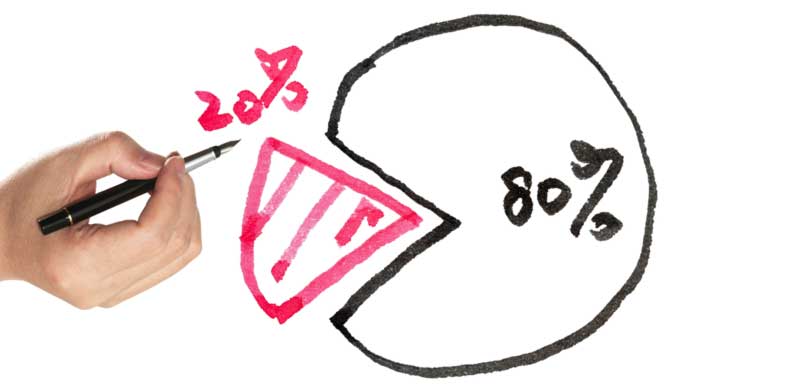 Why The Eighty Twenty Rule Rocks!
Why The Eighty Twenty Rule Rocks!
Introduction
Many business experts have long promoted the notion that 80 percent of sales come from 20 percent of a company’s products or services. This ratio — commonly referred to as the “Eighty Twenty Rule” — has been applied over the years to a wide variety of activities in business and beyond. In essence, the “Eighty Twenty Rule” emphasizes that a significant majority of sales (for example) can be generated by a minority of customers buying a minority of types of products.
The Eighty Twenty Rule has been proven for many decades. Yet many businesses — even those just getting started — ignore this rule, and produce a myriad of styles, colors, sizes, models and features to serve what they presume to be an endless stream of “niches.”
Often, by taking their eye off the ball in this way, many companies fail.
“Eighty Twenty Rule” Versus “The Long Tail”
Chris Anderson’s recent book, The Long Tail promotes market saturation and segmentation — the opposite of the Eighty Twenty Rule. Anderson insists that the internet and other non-traditional approaches to marketing provide a great opportunity to offer consumers almost unlimited variety and flexibility. His logic would argue that creating a multitude of products and services better enables a company to tap into every possible niche.
But is this logic sound? And, in particular, is it sound for young companies and new startups?
I am not convinced that “The Long Tail” approach to business is a valid one, especially for companies just getting started and with limited resources. On the contrary, I am convinced that, the Eighty Twenty Rule “Rocks” for such businesses, enabling them to focus on doing what they do well, and not losing sight of key priorities needed for growth.
In 1906, Italian economist Vilfredo Pareto observed that twenty percent of the people owned eighty percent of the wealth. The general principle is called “The 80:20 Rule.
In “Harvard Business School Confidential,” author Emily Chan validates the Eighty Twenty Rule in a variety of business contexts. And in my own research on this subject, I have identified numerous additional business examples substantiating that very few products or services increase profits by increasing offerings, especially during the early stages of a company’s development or brand evolution.
The upshot of such segmentation and “line extension” is that many managers of small companies waste time, money, and inventory dollars, spreading themselves too thin, and frequently adding confusion and complexity to their operations.
Recent downturns in the economy have produced a great opportunity for savvy business people to reduce the proliferation of products that just aren’t producing, and to focus on their core products and services. Examples of excessive brand proliferation include:
- The thousands of brands, products and colors in cosmetics often confuses consumers more than it helps them
- It took a crises for GM to realize it did not need to duplicate Buick, Pontiac and Oldsmobile products, models, dealers and advertising to basically sell the same car
- Have we really lost anything in the last few years without the endless proliferation of credit card offerings?
- Few want to admit that much of the success of Costco is the result of focusing on the best price for the things that sell rather than proliferating a multitude of product line extensions.
Reducing Excessive Niche Products
There are various ways to reduce excessive niche products, increase productivity, and increase sales. These are all based on the policy of insuring that key items are stocked in adequate supplies while maintaining low inventory on low volume items. Admittedly, this approach applies to many types of business, but is not necessarily applicable to those based on serving diverse needs such as parts suppliers or retailers featuring selection or niche markets. Some examples are below:
- Several years ago when I was head of a leading moderate-priced dress shirt company, we simply cut our on-shelf inventory in half by consolidating sleeve length. For example we used to make separate 33 and 34 inch lengths, but we consolidated them into a 33/34 length category which was actually a 34 inch length. The results were spectacular. Returns went down because people didn’t really know their size and often bought them too small. Sales went up because we were able to carry more of fewer items in stock. Retailers also used some of the inventory reduction to buy more styles and colors which further increased sales. And, of course, we reduced inventory and markdowns at all stages of the logistics chain.
- Nordstrom’s has taken this one step further by consolidating their entire on-line and in-store inventory into one system. The stores stock all the key items, sizes and colors but allow the customers to order online or from other stores with 1-2 day delivery if they are out of stock.
- The most important requirement is to be in stock with what sells and feature those items. This means better merchandising by size, color, price and features. Many times this can improve sales by reducing consumer confusion and focusing on the featured products and their features. Since all business need to deal with challenges managing inventory, time and space, we sometimes eliminate enough stock in key items to proliferate sales in items that don’t sell anyway.
Summary
The best solution to many of our problems with poor sales may simply be to get rid of many of the poorer performing products and focus more on the best performing ones. Food and restaurants are a great example. We seem obsessed with the latest new restaurant or food fad while hamburgers, pizza, steaks and a few other restaurant types really dominate sales.
Why do I think that “Eighty Twenty Rule” Rocks?
“Eighty Twenty Rule” rocks because providing excellence in what we do best is simply a better strategy than diverting our time, money and energy in things that won’t work.